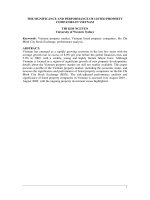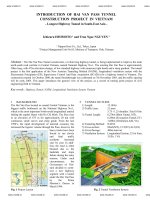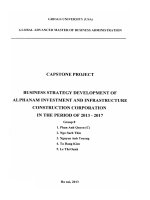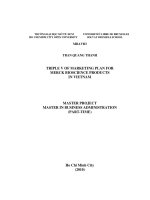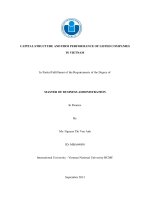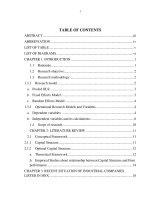Determinants of capital structure for listed construction companies in vietnam
Bạn đang xem bản rút gọn của tài liệu. Xem và tải ngay bản đầy đủ của tài liệu tại đây (853.74 KB, 63 trang )
UNIVERSITY OF ECONOMICS
HO CHI MINH CITY
VIETNAM
INSTITUTE OF SOCIAL STUDIES
THE HAGUE
THE NETHERLANDS
VIETNAM - NETHERLANDS
PROGRAMME FOR M.A IN DEVELOPMENT ECONOMICS
DETERMINANTS OF CAPITAL STRUCTURE
FOR LISTED CONSTRUCTION COMPANIES
IN VIET NAM
BY
NGUYỄN THỊ MỸ KHÁNH
MASTER OF ARTS IN DEVELOPMENT ECONOMICS
HO CHI MINH CITY, November 2013
UNIVERSITY OF ECONOMICS
HO CHI MINH CITY
VIETNAM
INSTITUTE OF SOCIAL STUDIES
THE HAGUE
THE NETHERLANDS
VIETNAM - NETHERLANDS
PROGRAMME FOR M.A IN DEVELOPMENT ECONOMICS
DETERMINANTS OF CAPITAL STRUCTURE
FOR LISTED CONSTRUCTION COMPANIES
IN VIET NAM
A thesis submitted in partial fulfilment of the requirements for the degree of
MASTER OF ARTS IN DEVELOPMENT ECONOMICS
By
NGUYỄN THỊ MỸ KHÁNH
Academic Supervisors: Assc. Prof. Dr. NGUYEN TRONG HOAI
HO CHI MINH CITY, November 2013
CERTIFICATION
“I certify that the substance of this thesis has not already been submitted for
any degree and have not been currently submitted for any other degree.
I certify that to the best of my knowledge and help received in preparing this
thesis and all sources used have been acknowledged in this thesis.”
NGUYỄN THỊ MỸ KHÁNH
ACKNOWLEDGMENTS
The process of writing a thesis is a collaborative experience involving the
support and helps from many people. I want to express my gratitude to those who
give me the tremendous support to complete this thesis.
I am deeply indebted to my parents and my husband for their invaluable
support and constant encouragement. From my early childhood, my parents always
teach me valuable lessons on the importance of learning. The boundless love of my
parents have accompanied with me as I continue my long journey on the pathway of
intellectual acquisition.
I wish to express my heartfelt gratitude to Associate Professor Doctor Nguyen
Trong Hoai, Lecturer at Department of Economic Development, University of
Economics (HCMC), my supervisor, for his valuable suggestions during the time I
write this thesis. His wide knowledge, excellent advice and logical way of thinking
have provided me a good basis in present this thesis.
In addition, my special thanks should send to Dr Trương Đang Thuy for their
help and sharing of their resources to complete this thesis successfully and in time.
Finally, I take a pride in myself for working very hard to finish this thesis. I
realize that after each success stories, there is a process of lots of hard works,
difficulties, obstacles and overcoming. Even in the hardest time when I write this
thesis, I always believe that great efforts will eventually to be paid off. Thank for
the great time to learn and to grow up.
Nguyễn Thị Mỹ Khánh
November 2013
TABLE OF CONTENTS
LIST OF TABLES ....................................................................................................1
ABSTRACT ...............................................................................................................2
CHAPTER I. INTRODUCTION .............................................................................3
1.1 Problem Statement.............................................................................................3
1.2. Research Objectives .........................................................................................4
1.3. Research Questions ..........................................................................................5
1.4 Research Methodology ......................................................................................5
1.5. Research contribution .......................................................................................5
1.6. Research Structure ............................................................................................6
CHAPTER II. LITERATURE REVIEW .............................................................7
2.1 Key concepts: ....................................................................................................7
2.2 Theoretical review .............................................................................................8
2.2.1 Trade-off theory ..........................................................................................8
2.2.2 Pecking order theory .................................................................................10
2.3 Determinants of leverage: ...............................................................................12
2.3.1 Leverage and Tangibility: .........................................................................13
2.3.2 Leverage and Profitability ........................................................................15
2.3.3 Leverage and Size .....................................................................................16
2.3.4 Leverage and Growth ...............................................................................17
2.3.5 Leverage and Liquidity .............................................................................18
2.4 Empirical studies review on determinant of leverage: ....................................19
2.4.1 Empirical evidences finding from the world: ...........................................19
2.4.2 Empirical evidences from Vietnam : ........................................................20
CHAPTER III. RESEARCH METHODOLOGY ...............................................23
3.1 Overview the construction industry in Vietnam: ............................................23
3.2 Data and description variable ..........................................................................25
3.2.1 Data ...........................................................................................................25
3.2.2 Description variable ..................................................................................26
3.2.2.1 Dependent Variable............................................................................26
3.2.2.2 Explanatory Variables ........................................................................27
3.3 Method of estimation .......................................................................................28
3.3.1 Fixed effect (FE) estimator : .....................................................................29
3.3.2 Random effect estimator (RE): .................................................................29
3.3.3 Hausman specification test : .....................................................................30
3.4 Hypothesis .......................................................................................................30
CHAPTER IV. EMPIRICAL RESULTS .............................................................32
4.1 Descriptive Statistic .........................................................................................32
4.2 Empirical Result ..............................................................................................34
4.2.1 Hausman test: ............................................................................................34
4.2.2 Fixed effects model (FEM) .......................................................................36
4.2.2.1 Tangibility ..........................................................................................37
4.2.2.2 Profitability ........................................................................................38
4.2.2.3 Size .....................................................................................................39
4.2.2.4 Growth ...............................................................................................39
4.2.2.5 Liquidity .............................................................................................40
4.3 Public and Private Firm Comparison ..............................................................41
4.3.1 Descriptive Statistic ..................................................................................41
4.3.2 Determinants of Financial Leverage .........................................................42
CHAPTER V. CONCLUSION AND RECOMMENDATION ...........................44
5.1 Conclusion .......................................................................................................44
5.2 Policy recommendation: ..................................................................................46
5.2.1 Recommendations for construction firms: ...............................................46
5.3 Limitation: .......................................................................................................49
REFERENCE
APPENDIX
ABBREVIATIONS
SMEs: small and medium size enterprises
WTO: World Trade Organization
GDP: Gross Domestic Product
FE: Fixed effects
RE: Random effects
TEs: Transition economies
LIST OF TABLES
Table 2.1 Summary of leverage determinant ............................................................18
Table 3.1 Variable, Description and expected sign ..................................................28
Table 4.1 Descriptive Statistics of Leverage, short-term leverage, long-term
leverage and Explanatory Variables with construction firms ...................................33
Table 4.2 Hausman Test ...........................................................................................35
Table 4.3: Result of Fixed effects regression in construction sector ........................36
Table 4.4 Summary of leverage determinants ..........................................................37
Table 4.5 Descriptive Statistics of Public and Private Firms ....................................41
Table 4.6 Regression Result of Public and Private Firms.........................................42
1
ABSTRACT
This study explores the determinant of capital structure of Vietnam listed
construction companies using panel data for the period of 2007-2012. Tangibility,
profitability, size, growth and liquidity use as independent variables. Total leverage,
short-term leverage and long-term leverage were dependent variable. The research
finds that all the selected independent variables were significantly associated to at
least one of the leverage ratios except profitability. Profitability seems to have no
significant effect to the capital structure of Vietnamese construction listed firms. A
positive significant related to leverage and tangibility and growth variables; a
negative relationship between leverage and liquidity also supported the implication
of pecking order theory while a positive significant of size variable confirmed to
prediction of trade off theory. The study also finds that there are different in
determinants of capital structure between public and private firms in construction
industry about the profitability and growth variables. Size, profitability and liquidity
effect to leverage of public firms while size, growth and liquidity have a relation to
leverage of private firms. Public firms tend to use more debt than private firms.
Keywords: capital structure, leverage, construction companies
2
CHAPTER I
INTRODUCTION
1.1 Problem Statement
Capital structure is not a new area to study. From the first research of capital
structure was presented by Modigliani & Miller (1958), after that a lot of researches
try to identify determinants of capital structure. But the results are still an argument
problem in financial and inconsistent among researchers at different countries and
different industries. Myers (1984) also showed that “the average debt ratio will vary
from industry to industry because assert risk, asset type and requirement for external
fund also vary by industry”. In Vietnam, there are only a limited number of studies
on determinant of capital structure among Vietnam firms. Some of these studies just
focused on listed firms (Dzung Nguyen et al 2011) or small and medium size
enterprises (SME) (Nguyen, Tran Dinh Khoi 2006) and the empirical results also
have conflicts with the results from many other researches in the world.
Corporate financing means that all the money economy expressed through
mobilizing and using capital in order to maximize the value of company. In there,
capital structure is the ratio between debt and equity to finance for the enterprise.
Specifying the capital structure is an important issue not only for the manager but
also for the financial officer to build up the logical funding policy to ensure the
illiquid and to salvage the effect of debt margin to upgrade the value of the
company. In the process of activity the enterprises have to face the important
decisions such as investment, finance, dividing dividend, etc. Each decision effects
to the value and the capital structure of the enterprise. Decisions involving capital
structure are vital for every business organization. Management has to carefully
ensure that their capital structure decisions maximize their firm value.
However, in order to achieve optimal capital structure, the manager has to
consider how factors affect to capital structure of firms. There are many empirical
studies about the determinant of capital structure, each research disperse in different
3
fields of economy. But the research of determinant of capital structure of
construction sector is almost limited. In other word, construction sector is special
business area, the capital resources are appropriated for a long time and firms
depend too much on debt. In the past years, especially the period from 2008 to
2012, Vietnam in general and construction sector in particular is almost affected by
the economy crisis. This was a bad period for many enterprises in Vietnam. The
operating of construction sector is very difficult due to the frozenness of real estate
market.
Some had even been forecasted to go out of business or completely
bankrupt. At the end of the year 2012, 2,110 construction firms must stop operating.
The enterprises is lack of capital resources to operate because it is difficult for them
to borrow money from bank due to tightening monetary policy through controlling
credit strictly and limiting in supply money for the economic to control inflation.
The interest from the bank is very high. Shorting of capital to invest new project, no
mobilizing external resources are a big problem for the financial manager of
construction firms. So restructuring of capital structure becomes the most important
problem for the construction sector firms. Firms need to have suitable leverage to
improve financial ability, avoid risk of financial. This research will find the
determinants of capital structure in construction firms and consider if trade off
theory and pecking order theory have explained capital structure of construction
firms.
1.2. Research Objectives
The objective of this research is to study the factors that affect to the capital
structure of Vietnam’s construction sector companies in the stage of 2007 - 2012.
This study also examine whether the financing behavior in construction firms can
be explain by the main capital structure theories such as trade-off theory and
pecking order theory. In other hand, the research also considers the difference in
determinant of capital structure between public and private firms in construction
industry.
4
1.3. Research Questions
This study aims to answer many questions about the capital structure of
construction sector companies in Vietnam such as:
Question1: What are determinants of capital structure of Vietnam construction
sector companies?
Question2: Does trade-off theory and pecking order theory explain the determinant
of capital structure of Vietnam construction firms?
Question 3: Is there any difference in determinant of capital structure between
public and private firms in construction industry in Vietnam?
1.4 Research Methodology
This study uses annual panel data of 49 construction listed companies in Ho
Chi Minh and Hanoi stock exchange for the period 2007 to 2012.
To find the impact of independent variables such as tangibility, profitability,
firm size, growth and liquidity on leverage of firms, we used panel regression
methods: Fixed effects or Random effects which is decided by Hausman
specification test.
1.5. Research contribution
The contribution of this research is to identify the factors effecting to capital
structure of the construction sector companies. This research is also to provide an
empirical evidence to test the financial theories involving trade-off theory, pecking
order theory to the construction sector companies. This study is to distinguish the
difference in determinant of capital structure of public and private corporations in
construction industry.
5
1.6. Research Structure
The structure of this study is divided into five chapters. The first chapter is to
introduce the research with research objective, research methodology, research
contribution, research structure and main questions of the study. The second chapter
is literature reviews. In this chapter, some key concepts, major theories,
determinants of leverage and some empirical studies related to capital structure of a
firm will be presented. The third chapter presents research methodology from
theory framework to data collection method. The next chapter shows how to
analyze data and result of econometric regressions. The final chapter is conclusions
of this empirical study, suggest recommendations and limitations of the research.
6
CHAPTER II
LITERATURE REVIEW
This chapter presents about key concepts of capital structure as well as
leverage, short-term leverage and long-term leverage. Next, it reviews some popular
capital structure theories such as trade off theory, pecking order theory and
considers the prediction of two theories about some variables effecting leverage.
Finally, some empirical studies in the world and Vietnam related to these factors
will be presented.
2.1 Key concepts:
Capital structure is the way that a company finances its assets through
combination of debt, common equity and preferred equity. It is measured by the
ratio of debt to total assets (also called leverage), ratio of equity to total assets or
ratio of debt to equity.
The ratio of debt to total assets (or leverage) will be used to define for
capital structure in this study. There are three type of leverage - balance sheet,
economic and embedded. The first definition is based on balance sheet concepts,
the second on market dependent future cash flows, and the third on market risk
(Katia D’Hulster 2009). This study uses the balance sheet leverage which basing
on the book value in company’s balance sheet to calculate the ratio debt to total
assets
Financial distress or Bankruptcy cost: financial distress refers to
condition in which a firm can’t pay off its debt obligation. Raising the leverage
ratio increase the probability of financial distress. Bankruptcy cost is understood as
the increase costs when the firms finance with debt instead of equity that result
from a higher probability of bankruptcy. If the financial distress can’t be relieved,
it leads to bankruptcy.
7
Agency cost: Jensen and Meckling (1986) defined agency cost as a
cost of the agency relationship which is “a contract under which one or more
persons (the principal (s) engage another person (the agent) to perform some
service on their behalf of which involves delegating some decision making
authority to the agent”).
In this paper, we use “leverage” as the main concept. Besides, we also
consider short-term leverage and long-term leverage as dependent variables. Shortterm leverage is a ratio of short-term debts to total assets. In other word, Short-term
debt is a debt which maturity is within one year. If maturity is over one year, it is
classified as a long-term debt. Hence, long-term debt is a ratio of long-term debts to
total assets.
2.2 Theoretical review
The first modern theory of capital structure is Miller and Modigliani theory
studied by Miller and Modigliani in 1958. This theory aims to analyze the impact of
tax and cost of capital to the change of capital structure of firms. The theory also
can explain the relationship among of the value of company, cost of capital and
leverage of firm. After the Miller and Modigliani theory, there are a number of
theories on capital structure that have been developed. However, in this paper, we
will consider two popular theories including trade off theory and pecking order
theory. This chapter will review these theories that contribute considerably to
capital structure of a firm, figure out what each theory predict and compare some
empirical studies with the prediction of these theories.
2.2.1 Trade-off theory
Myer (1984) argued that firms which follow this theory try to have their
target debt to equity ratio and achieve this ratio for having an optimal capital
structure by balancing the cost and benefit. Firm managers are likely to establish an
optimal debt-to-equity ratio to maximize firm value. The benefits are the tax saving
8
benefits of debt, the interest tax shield and the costs which include the financial
distress cost and bankruptcy cost. The cost of financial distress is the most
influenced critical factor serious for growth firms with higher proportions of
intangible assets. The interest tax shield becomes increasingly important with higher
profit. This tax shield allows firms to pay lower tax than they should when those
firms use debt capital instead of using only their own capital. It is a trade off of
costs and benefits of borrowing, holding the firm’s assets and constant investment
plans. The firm is guessed to substitute debt for equity or equity for debt until theirs
firm value are maximized.
Frank and Goyal (2005) argued that trade off theory divided into two ways
consisting of the static trade off theory and the target adjustment behavior (or
dynamic trade-off theory). A firm follows the static trade off theory if the firm’s
leverage is determined by a single period trade-off between the tax benefit of debt
and the deadweight cost of bankruptcy. In addition, a firm is said to show target
adjustment behavior if it has a target level leverage and if deviations from that
target gradually move over time.
In the study of Myers (1984),’the capital structure puzzle’, firms applying the
static trade-off theory should set a target debt-to-equity ratio and attempt to achieve
it step by step. However, according to Myers, managers do not want to issue equity
if they predict that it is undervalued in the market. As a result, investors should be
aware that issuing equity will happen if equity is over-priced. Consequently,
investors appear to have a negative opinion of new equity issue of firms and thus
board of managers should limit new equity issue as much as possible.
Myers (1984) found that three factors including costs of adjustment, debt and
taxes, and cost of financial distress would impact financial behavior of firms under
static trade-off theory. This theory predicts a positive relationship between tangible
assets and financial leverage and between profitability and financial leverage.
9
Empirical studies that support the trade off theory document that capital
structure is influenced by firm factors such as size, grow opportunity, asset
tangibility and tax rate in a manner consistent with the prediction of trade off
hypothesis (Rajan and Zingales 1995, Deesomsak at al 2004, Frank and Goyal 2005
). However, there are also some studies found the negative correlation between debt
and profitability that does not support the theory (Nguyen et al 2012, Fama and
French 2002)
2.2.2 Pecking order theory
Pecking order theory is the best known alternative to the trade-off model.
Pecking order theory was first studied by Donaldson in 1961 and it was modified by
Myers in 1984. In contrast to the static trade off theory, Pecking order theory does
not clearly define any target debt ratio so there is no target capital structure.
According to pecking order theory of capital structure, firm managers know more
about the real value and risk of the company than outsider investor. In addition,
insiders may hide good investment opportunities to take advantages comparing to
common investors. That is the asymmetric information between insiders (managers
of firms) and common investors (outside of firms) as external financing.
Asymmetric information affects the choice between internal and external financing
and between new issues of debt and equity securities. This leads to a pecking order,
in which investment is financed first with internal funds, reinvested earnings
primarily; then by new issues of debt; and finally with new issues of equity. New
equity issues are a last resort when the company runs out of debt capacity, that is,
when the threat of costs of financial distress brings regular insomnia to existing
creditors and to the financial manager. So the pecking order theory can explain the
reason that most profitable companies tend to use debt less. They seemly do not
need external fund. On the contrary, less profitable companies use more debt
because they do not have internal fund and because debt has lower flotation and
information cost compared to equity.
10
In contrast to the prediction of trade-off theory, internal funds and external
funds are used orderly following the criteria of at first internally with retained
earnings, debt, and finally with an issue of new equity.
The theory works on the assumption of asymmetric information which
indicates that managers know more about their company than outside investor.
According to the states of the theory, firms prefer financing from internal as
retained earnings to financing from external funds as debt and finally from an issue
of new equity. At the top of the model, internal finance is chosen even with sticky
dividend policies. If internally generated cash flow is less than investment outlays,
firms would move away from marketable securities portfolio. At the bottom,
external finance is required in the following order from debt, hybrid securities to
issuing equity at last. Myers debates that it is difficult for a firm to achieve an
optimal capital structure with its equity at the top and the bottom of the ‘pecking
order’. Moreover, the leverage target of firms is difficult to approach if the firms
have two types of equity as internal and external. There are several advantages
including no flotation costs and no disclosure of the firm’s proprietary financial
information when the firm follows internal funds. In addition, using internal funds
may make new potential investment chances for the firms and increase profitability
as a result of undertaking such investments.
There are three factors that pecking order theory is based on and that must be
considered by firm when raising capital. Firstly, internal fund are cheap to use (no
insurance cost) and require no private information release. Secondly, debt financing
is better than equity financing. And lastly, managers tend to know more about the
future performance of firm than lenders and investors. Because of asymmetric
information, investors may make inferences about the value of the firm based on the
external source of capital the firm chose to raise. External financing using equity
inference-firm is currently overvalued. Financing by debt inference-firm is correctly
or undervalued.
11
Besides two theories of capital structure above, there are also have another
theories such as agency cost theory, market timing theory, signaling theory, etc. In
this study, we will only consider two main theories trade off theory and pecking
order theory to check whether they effect to capital structure choice in construction
listed firms in Vietnam.
2.3 Determinants of leverage:
There are a number of factors that effect to capital structure of enterprises
from many previous researchers. According to De Jong at al (2008), there are two
major type of variable as country- specific and firm-specific determinant factors that
affect to capital structure. Rajan and Zingales (1995) examined the determinants of
capital structure choice of public firms in G7 countries and concluded that many
variables such as company size, asset tangibility, firm growth, and profitability have
correlation with leverage. Booth et al (2001) found consistent relations between
firms’ profitability, asset tangibility, growth options and leverage. Harris and Raviv
(1991) has a brief result from many researches that “leverage increases with fixed
assets, non-debt tax shields, growth opportunities, and firm size and decreases with
volatility, advertising expenditures, research and development expenditures,
bankruptcy probability, profitability and uniqueness of product”.
In Vietnam, the research of Dzung Nguyen et al (2011) also found that
profitability and liquidity remain negative related to leverage while growth and
state-ownership have a positive impact. Size and tangibility have a positive
relationship with long-term leverage but a negative effect on short-term leverage.
Due to shortage of data, this study will base on some factors which are found
significant in research of Harris and Raviv (1991) such as profitability, firm size,
growth rate, tangibility asset, and liquidity ratio (as in Zehra 2008) to check for
determinant of capital structure of Vietnam listed construction firms. Profitability,
tangibility and firm size are considered three of five factors that make changing up
to 27% of leverage in many studies before (Murray and Vidhan (2007)).
12
Two mainstream theories: pecking order theory and trade off theory are
applied to be explained determinant of firms in almost previous researches. Chen
(2004) examined the determinant of capital structure of China-listed firm for the
period from 1995 to 2000 concluded that the capital structure choices of Chinese
firms supported a new pecking order theory with such determinant as retained
earnings, equity and long-term debt. Some other studies also supported pecking
order theory in explaining better choice of leverage (De Jong et al (2008),
Nivorozhkin (2003), Friend and Lang (1988) whereas other researches also ague
leverage is consistent with prediction of both pecking order and static trade off
theory (Deesomsak et al (2004), Antoniou et al (2008)). Novorozhkin (2003) sum
up that pecking order theory explains important variation in corporate capital
structure choice in transitional economies. Dzung Nguyen et al (2011) concluded
that pecking order theory better explains financing decision in Vietnam than Trade
off theory.
This research will concentrate on both Pecking order and trade off theories to
find whether which theory is applicable to leverage of construction firm in Vietnam.
Pecking order theory seems to be better than trade off theory in explaining leverage
of firm because according to trade off theory, firms should take more debt to inherit
tax shield deduction, however, in reality, there are some firms with high profit take
less debt. This theory can’t explain for that. Pecking order theory proposes firms’
hierarchy of finance: retained earnings, debt and equity. The impact of each factor
to leverage will be explained according to the point of view of pecking order theory
in the section as follow.
2.3.1 Leverage and Tangibility:
According to trade-off theory, tangible assets serve as good collateral to
support debt. A firm with higher tangibility will use more debt than a firm with
higher intangibility assets because cost of financial distress is lower with high
tangibility. In contrast, if financial distress happened, intangibility assets are more
13
likely to lose value. So it is expected that there is a positive relationship between
tangibility and leverage of firm according to static trade-off theory.
According to Myers (1984) in pecking order theory, a high tangible assets
level may mitigate the asymmetric information associated with financing cost
thanks to being secured by collateral. As a result, a positive relationship is expected
between financial leverage ratio and tangible assets level.
Timan and Wessel (1988), Rajan and Jingales (1995), Faman and French
(2000) argued that tangibility should be an important factor of leverage. Chen
(2004) found a positive relationship between tangibility and leverage in China. He
suggested that asset tangibility is an important criterion in bank’s credit policy, and
this is true for long-term debt. Booth et al (2001) investigated the determinant’s
capital structure of 10 developing countries and found generally negative
correlation between total debt ratio and tangibility. He also suggested the existence
of positive between long-term debt and tangibility of assets. Rajan and Zingales
(1995), Murray and Vidhan (2007) also found the result supporting pecking order
theory and trade off theory that leverage have a positive related to tangibility. The
study of Antoniou (2002) is about the determinant of capital structure in European
countries found different results across countries. There is a positive relationship
between leverage and tangibility in Germany, but negative in the UK and
insignificant in France
In Vietnam, it is more difficult for firms to borrow money from capital
market than traditional bank. Bank usually requires fixed assets as collateral when
firms ask for borrowing money. If a firm has more fixed assets with high collateral
value, it is easy for it to borrow money from the bank. This study takes fixed assets
to total assets as independent variable, so the first hypothesis is conducted for the
relationship between tangibility and leverage as follow:
Hypothesis 1: There will be positive relationship between tangibility and
leverage
14
2.3.2 Leverage and Profitability
The relationship of leverage and profitability is contradiction in the
prediction of theories. Pecking order theory (Myers & Majluf (1984)) suggested a
negative relationship between profitability and leverage. Because of asymmetric
information condition, cost of collecting inside capital will be always lower than
outside capital. Firm managers prefer to finance internally than finance externally
by using retained earnings. Especially, firms with higher profitability will have
more retained earnings than firms without or less profitability. So firms will use this
resource to finance its operation without depending on external of fund to avoid
problem of changing interest rate or pressure of payment at due day, so level of
ratio of debt will be lower. Jensen (1986) predicted a negative relationship if the
market for corporate control is ineffective. Some empirical studies also supported a
negative relationship between profitability and leverage (Frank and Goyal, 2009),
(Huan and Song, 2006), (Tong and Green 2005). Rajan and Zingales (1995) for G7
countries, Wald (1999) in developed countries also found a negative correlation
between leverage and profitability.
Contrary to pecking order theory, trade off theory supported a positive
relationship between leverage and profitability. Firms have a target debt ratio and
attempt to achieve this ratio for having an optimal capital structure by balancing the
cost and benefit of debt. Any decrease in cost of debt allows firm to adjust target
debt ratio. The firms use more debt will have advantage from tax shield. Frank and
Goyal (2009) suggested that expected cost of financial distress is low for profitable
firms thus finding tax shield more valuable. Philip et al (2003) confirm that a firm
with high profitability may create belief in lender, so it is easy for them to borrow
money than firms with lower profitability. Nivorozhkin (2003, 2005) suggested that
tax shields are really significant for firms with higher and stable income.
In context of Vietnam, the research of Dzung Nguyen et al (2011) and
Nguyen Tran Dinh Khoi (2006) also concluded that profitability has a negative
relationship with all measure of capital structure. These result supported the pecking
15
order theory that firm prefers to use the internal source of finance to debt. It seems
that pecking order theory is more suitable to explain for leverage of Vietnam firms.
So we hypothesize with pecking order theory that:
Hypothesis 2: There will be a negative relationship between leverage and
profitability.
2.3.3 Leverage and Size
Theoretical prediction shows contradiction views about relationship between
leverage and size.
The pecking order theory specifies that larger firm display lower information
asymmetry with financial market and are able to issue more equity compared to
small companies. Most large companies can reach non-bank debt financing while
smaller companies are often unable to access it. Pecking order theory predicted a
negative correlation between leverage and size because larger companies are well
know and have longer history of adding retained earnings to their capital structure
(Frank and Goyal 2009). So firms which use retained earnings to finance their
investment should have less leverage. According to pecking order theory, firms
prefer internal financing than external financing. And larger firms usually have
more profit as compared to small firms. This shows that leverage is negative
associated with size.
In other hand, trade off theory predicted a positive relationship between
leverage and size. It is expected to have higher leverage levels in larger companies,
or an increase in size of a firm often leads to an increase of its financial leverage.
Bankruptcy will less impact to large firms so it is easy for them to borrow with
lower interest (Pinches and Mingo (1973)), so the debt ratio will be higher. Rajan &
Zingales (1995) stated that larger firms tend to reduce the probability of insolvency
due to their diversification, and have better access to debt from financial institutions
than smaller firms.
16
In Vietnam, the study of Nguyen and Ramanchara (2006) found significantly
positive relationship between firm size and all measure of capital structure. Larger
firms will use more debt to finance their operation and smaller firms will use their
own equity for operation financing and employ less debt. Dzung (2012) also
suggested that Size is negative related to short-term leverage and positive associated
with long-term leverage. Therefore, in this research, the relationship between firm
size and leverage is predicted to be positive.
Hypothesis 3: Trade off theory suggested a positive relationship between size
and leverage.
2.3.4 Leverage and Growth
There are conflict views about the relationship between leverage and growth.
Growth is raising cost and probability financial distress when the companies
borrow more debt to support growth opportunity. Raising cost of financial distress
may limit firm from borrowing more. It means that trade-off theory suggested a
negative relationship between growth and leverage. Rajan and Zingales (1995),
Timan and Wessel (1988) also supported a negative relationship between leverage
and growth.
Pecking order theory predicted a positive relationship between growth and
leverage. According to Myer and Majluf (1984) information asymmetry will raise
external funds to finance growth. The company first finances its project by internal
financing (Rose, et al 2008). Tong and Green (2005) found a signification positive
relationship between growth and debt ratio. In Vietnam, Nguyen and Ramanchanra
(2006) supported that growth is positive associated with leverage. So it is
hypothesized that:
Hypothesis 4: There was a positive between leverage and growth.
17
2.3.5 Leverage and Liquidity
Trade-off theory suggested a positive relationship between liquidity and
leverage. Firms with high liquidity ratio may borrow more debt because they have
ability to meet their liabilities obligation. This idea was supported by Zera (2008)
about UK listed companies 1998-2007.
In contrast to trade off theory regarding liquidity, according to pecking order
theory, there is a negative relationship between liquidity and leverage because firm
with high cash and liquid asset will prefer this available internal fund to borrowing.
Deesomsak et al (2004) suggested that there was a negative relationship between
leverage and liquidity for all countries they studied. They stated that their liquid
assets were tended to use to finance their investment in preference to raising
external debt. In Vietnam, supporting the ideas liquid firms prefer to use
accumulated cash and liquid assets rather than to resort to external finance, Dzung
Nguyen et al (2012) also found a negative relationship between liquidity and total
leverage and short-term leverage which supported pecking order theory. So in this
study, it is hypothesized that:
Hypothesis 5: There is a negative correlation between leverage and liquidity.
Table 2.1 Summary of leverage determinant
Trade off theory
Pecking order theory
Hypothesis
+
+
+
Profitability +
-
-
Size
+
-
+
Growth
-
+
+
Liquidity
+
-
-
Tangibility
Source: by the author
18



